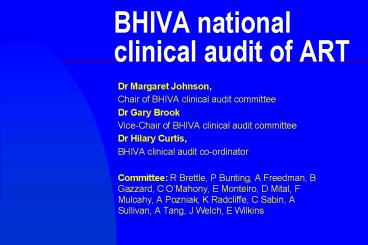BHIVA national clinical audit of ART - PowerPoint PPT Presentation
1 / 21
Title:
BHIVA national clinical audit of ART
Description:
Committee: R Brettle, P Bunting, A Freedman, B Gazzard, C O'Mahony, E Monteiro, ... single or boosted 'Non-standard' combinations ... – PowerPoint PPT presentation
Number of Views:56
Avg rating:3.0/5.0
Title: BHIVA national clinical audit of ART
1
BHIVA national clinical audit of ART
- Dr Margaret Johnson,
- Chair of BHIVA clinical audit committee
- Dr Gary Brook
- Vice-Chair of BHIVA clinical audit committee
- Dr Hilary Curtis,
- BHIVA clinical audit co-ordinator
- Committee R Brettle, P Bunting, A Freedman, B
Gazzard, C OMahony, E Monteiro, D Mital, F
Mulcahy, A Pozniak, K Radcliffe, C Sabin, A
Sullivan, A Tang, J Welch, E Wilkins
2
2002 audit preliminary results
- Survey of
- Clinic practice policies on treatment
initiation - Follow-up of 2001 audit
- Arrangements for maternity care
- Case note review
- Patients starting treatment from naive
3
Characteristics of participating centres
NB totals do not add because some centres did not
state their size and/or region.
90 centres stated their actual case-load (HIV
patients seen in preceding 6 months). The total
for these 90 centres was 21791.
4
Growth in HIV case-loads over past year
Percentage of centres
Change in number of cases
5
Local policies on starting treatment
- 84 (74) centres say their policy is to follow
BHIVA guidelines - 15 (13) have local policy/guidelines which
supplement BHIVA - 4 (4) have no local policy/guidelines
- 10 (9) did not answer.
- 38 (34) have local policy/guidelines on
adherence - 66 (58) do not
- 9 (8) did not answer.
6
Restrictions on choice of ART drugs
- 99 (88) of centres have no restrictions
- 2 (2) have restrictions due to cost
- 2 (2) have restrictions due to clinic policy
- 1 (1) has restrictions for other reasons
- 9 (8) did not answer.
7
Clinics stated practice re follow-up of patients
starting ART from naive
- First review of patients starting ART
- 71 (63) of centres within 1-2 weeks
- 33 (29) at 2-4 weeks
- 2 (2) at 4-8 weeks
- 7 (6) did not answer.
- First VL after starting ART
- 43 (39) of centres within 4 weeks
- 20 (18) at 6 weeks
- 20 (18) at 7-8 weeks
- 20 (18) at 10-12 weeks
- 10 (9) did not answer.
8
Pharmacy arrangements
- 34 centres (31) have dedicated HIV pharmacist
support however, as these are larger centres
they serve 73 of the total reported patient
case-load. - 20 centres (18, serving 6 of caseload) have
pharmacist(s) with a special interest in HIV and
42 (38, serving 14 of caseload) use generic
hospital pharmacy services. - 1 centre (1, serving 0.2 of caseload) used
community pharmacists and 13 (12, serving 7 of
caseload) did not say.
9
Patient data starting treatment from naive
- 942 patients
- 56 male, 44 female
- 55 Black-African, 36 white
- Stated reasons for starting treatment included
- Disease progression 802 patients (85)
- Prevention of vertical transmission 117 (12)
92 as sole reason - Patient choice 88 (9) 2 as sole reason both in
fact with CD4 lt230 - High viral load 275 (29) 9 as sole reason of
whom 6 in fact had CD4 lt 200 and/or CDC B/C - Recent seroconversion 25 (3)
10
Delay between diagnosis and starting treatment
Number of patients
Pre-treatment CD4
11
Tests done prior to treatment
12
Tests done prior to treatment
of patients tested
13
HIV resistance testing done prior to treatment?
of patients
14
Drug combinations
- 65 different combinations were reported.
- 844 (89.6) patients had been started on
standard combinations as recommended in BHIVA
guidelines shown left - 311 Combivir/efavirenz
- 203 Combivir/nevirapine
- 35 Combivir/lopinavir/r
- 29 Combivir/nelfinavir
- 87 Trizivir
- 23 Combivir/abacavir.
single or boosted
15
Non-standard combinations
- Reasons for choosing non-standard combinations
included - Efficacy (42 patients)
- Physician preference (36)
- Dosage/convenience (35)
- Toxicity minimisation (29)
- Clinical trial (25)
- Patient choice (22)
- Concomitant disease/ medication (20)
16
Use of tenofovir
- 42 patients had been started on tenofovir,
including 19 on lamivudine/efavirenz/tenofovir.
Reasons included - dosage/convenience (22 patients, including 12
started on lamivudine/efavirenz/tenofovir) - efficacy (19 patients, including 8 started on
lamivudine/efavirenz/tenofovir 3 on
Combivir/efarivenz/tenofovir) - toxicity minimisation (16 patients including 3
lamivudine/efavirenz/tenofovir 3
Combivir/efavirenz/tenofovir) - patient choice (14 patients, including 10
lamivudine/efavirenz/tenofovir) - clinical trial (5 patients)
- concomitant disease or medication (19 patients,
including 6 TB, 9 hepatitis B of whom 7 also on
lamivudine, 1 hepatitis C, 5 other)
17
Management of HIV and pregnancy
18
Antenatal testing rates
19
Follow-up of 2001 audit
- Feedback sessions were attended by
- Physician(s) at 41 centres
- Nurse(s) at 29 centres
- Pharmacist(s) at 10 centres
- Other(s) at 13 centres
20
Completing the audit cycle
- The large number of centres reporting no need for
change reflects the generally positive findings
of the 2001 audit.
21
Summary key points
- Most centres report gt15 rise in HIV caseload
over past year. - 38 of centres do not test VL until gt 6 weeks
after starting ART. - Significant delays can occur between diagnosis
and starting ART even for patients with extremely
low CD4. - BP, glucose /or lipids were not measured before
starting ART in a substantial proportion of
patients. - Although many different drug combinations were
used, most patients started on 2NRTI/NNRTI or
other standard HAART.






























